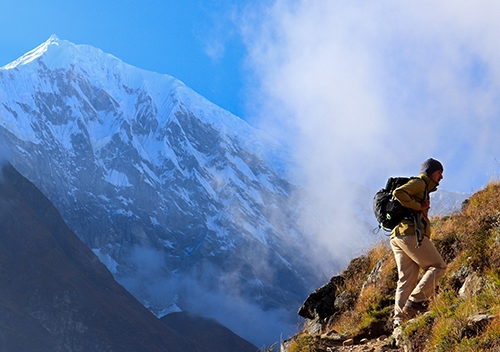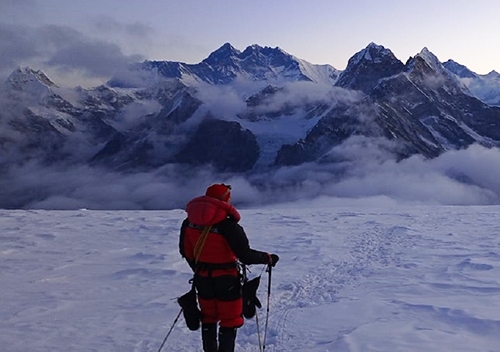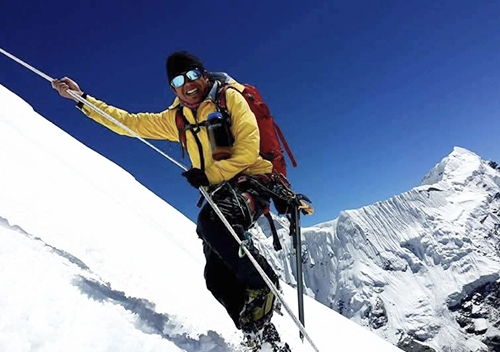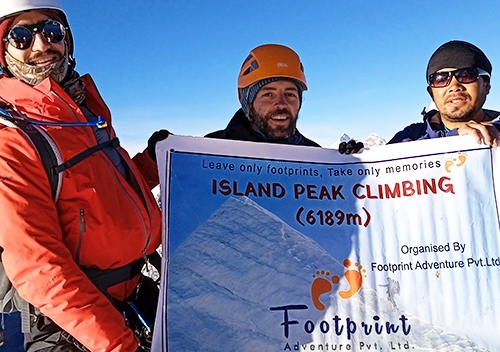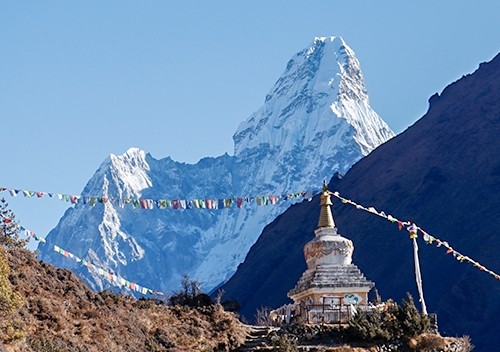It is undeniable that no other country is as rich in mountains as Nepal. It is undoubtedly the ultimate destination for mountain expedition and peak climbing in Nepal. It hosts 8 of the 14 world’s highest majestic Himalayas, over 6000 meters—8000 meters in height, and as many as 1,300 peaks, offering an abundance of an adventurous experience for peak climbers, trekkers, and travellers from across the world.
Home to the world's most iconic mountains, Nepal offers a variety of mountain climbing in Nepal for all levels of climbers. From well-known trekking peaks like Island Peak and Mera Peak to more challenging ascents such as Lobuche Peak, Footprint Adventure provides the expertise and support to make your climbing dream a reality.
Peak Climbing in Nepal Highlights
Nepal peak climbing offers a unique blend of adventure, natural beauty, and cultural immersion. The Himalayas are not just about high-altitude thrills; they are about experiencing the serenity of the mountains, the warmth of local communities, and the satisfaction of conquering some of the most stunning peaks on Earth.
- Access to over 1,300 peaks, including world-famous trekking peaks.
- Breathtaking views of the Himalayan ranges, including Everest, Lhotse, and Makalu.
- An opportunity to experience the rich culture and traditions of the Himalayan people.
Our Peak Climbing Packages in Nepal
Footprint Adventure offers a wide range of Nepal peak climbing packages in Nepal, tailored to suit different levels of experience and adventure.
1. Island Peak Climbing in Nepal (6,189m)
Island Peak, also known as Imja Tse, is the most popular trekking peak in Nepal. Located in the heart of the Everest region, this peak climbing Nepal is ideal for beginners looking to get a taste of high-altitude mountaineering. The summit offers spectacular views of the surrounding giants, including Lhotse and Nuptse.
Key Details:
Duration: 19 Days
Difficulty: Moderate
Best Season: Spring (April-May) and Autumn (September-November)
View Details on Island Peak Climbing in Nepal
2. Lobuche Peak Climbing in Nepal (6,119m)
Lobuche Peak presents a slightly more challenging climb, perfect for those who have some prior experience. This peak is a great choice for climbers heading to Everest Base Camp who want to add an exciting ascent to their trek.
Key Details:
Duration: 18 Days
Difficulty: Moderate to Challenging
Best Season: Spring (April-May) and Autumn (September-November)
View Details on Lobuche Peak Climbing in Nepal
3. Mera Peak Climbing in Nepal (6,476m)
Mera Peak, the highest trekking peak in Nepal, is an excellent choice for those seeking a less technical climb with rewarding panoramic views. The ascent is long but non-technical, making it accessible to fit trekkers with some high-altitude experience.
Key Details:
Duration: 21 Days
Difficulty: Moderate
Best Season: Spring (April-May) and Autumn (September-November)
View Details on Mera Peak Climbing in Nepal
4. Yala Peak Climbing (5,520m)
Yala Peak is a fantastic introduction to high-altitude climbing, located in the Langtang region of Nepal. This peak is ideal for those looking to experience climbing in the Himalayas without the technical difficulties of more challenging peaks. Yala Peak offers stunning views of the surrounding mountains and is an excellent choice for climbers who want to enjoy a less crowded and more serene climbing experience.
Key Details:
Duration: 14 Days
Difficulty: Moderate
Best Season: Spring (April-May) and Autumn (September-November)
View Details on Yala Peak Climbing in Nepal
5. Ama Dablam Expedition (6,812m)
Ama Dablam is one of the most iconic and challenging peaks in the Himalayas. Known for its stunning beauty and technical climbing routes, this expedition is suited for experienced climbers seeking a serious adventure. The climb offers unparalleled views of the Everest and Makalu regions and is renowned for its breathtaking, alpine climbing experience.
Key Details:
- Duration: 32 Days
- Difficulty: Challenging
- Best Season: Autumn (September-November)
View Details on Ama Dablam Expedition in Nepal
What’s Included in Our Packages?
Our peak climbing packages are designed to offer a hassle-free experience, with everything you need included:
- Permits and Fees: Climbing permits, National Park fees, and TIMS card. Learn more on
- Guides and Porters: Experienced climbing guides, porters, and support staff.
- Accommodation: Lodges and camping arrangements during the trek and climb.
- Meals: All meals during the trek and climb, including breakfast, lunch, and dinner.
- Climbing Equipment: Basic climbing equipment such as ropes, ice axes, and crampons (rental available). Learn more on packing lists and equipment here.
- Transportation: Airport transfers, domestic flights, and ground transportation.
- Emergency Support: Comprehensive first-aid kit, oxygen cylinders, and emergency satellite phone.
Why Book with Footprint Adventure?
Footprint Adventure is committed to providing safe, enjoyable, and memorable peak climbing experiences. Our team of trekking guides, who have extensive knowledge of the Himalayas, ensures that you are in safe hands every step of the way, which is why you should choose Footprint Adventure!
- Experienced Team: Our guides have years of experience and a deep understanding of the mountains.
- Safety First: We prioritize your safety with well-prepared itineraries and all necessary safety measures.
- Local Expertise: We offer insights into local culture, enhancing your overall experience.
- Customizable Packages: We tailor our packages to fit your needs, ensuring a unique adventure.
FAQs on Peak Climbing in Nepal
1. Do I need prior climbing experience for peak climbing in Nepal?
While some peaks like Island Peak are suitable for beginners, prior trekking or climbing experience is recommended for more challenging peaks such as Lobuche or Mera Peak.
2. What is the best time for peak climbing in Nepal?
The best time for peak climbing in Nepal is during the spring (April-May) and autumn (September-November) seasons when the weather is stable and visibility is excellent.
3. What kind of training is required for peak climbing?
Physical fitness is crucial for peak climbing. Cardiovascular training, strength training, and altitude acclimatization exercises are recommended.
4. What equipment is provided by Footprint Adventure?
We provide basic climbing equipment, including ropes, ice axes, and crampons. You can also rent additional gear if needed.
5. How do I obtain the necessary permits for peak climbing in Nepal?
Our packages include all necessary permits. We handle the entire permit process, so you won’t have to worry.
6. Which is the easiest peak to climb in Nepal?
Mera Peak is often considered one of the easier peaks to climb in Nepal. It's a popular choice for beginners due to its non-technical nature, though it still requires good physical fitness and acclimatization.
7. Do I need a guide for peak climbing in Nepal?
Yes, hiring a guide for peak climbing in Nepal is highly recommended. Local guides are experienced, know the terrain, and can help ensure your safety during the climb. Some peaks also require you to have a certified guide as part of the regulations.
8. What are the most popular peaks for climbing in Nepal?
Nepal's most popular climbing peaks include Island Peak, Mera Peak, Lobuche Peak, and Ama Dabalam. These peaks are well-known for offering thrilling experiences for climbers of varying skill levels.
The peaks of Nepal are thrilling adventures that offer breathtaking views, challenging climbs, and an opportunity to experience the local culture and lifestyle. With the right guidance and preparation, they can be unforgettable experiences that will stay with you forever. At Footprint Adventure, we are committed to providing our clients with the best possible peak climbing and expedition experience in Nepal.
At Footprint Adventure, we offer various peak climbing and expedition packages in Nepal that cater to different experience levels and preferences. Our packages include all necessary equipment, transportation, accommodation, and experienced guides and porters who ensure your safety and comfort throughout the journey.



